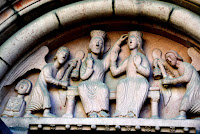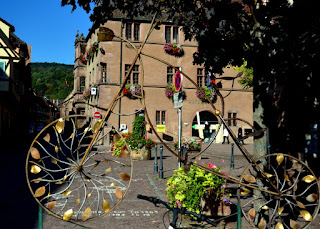 |
| Getting oriented in Kaysersberg |
The fortress that dominates the city skyline serves as a reminder of both its strategic importance and its warlike past, but we did not bother to walk up there. Together with the rest of Alsace-Lorraine, Kaysersberg was very much part of Germany during the period between the Franco-Prussian War and the First World War. The German influence is evident in shopkeeper's names and signposts.
 |
| Emperor Constantine |
 |
| 16th Century Fountain |
 |
| Romanesque portal on l'Église Ste Croix |
 |
| Weiss River |
 The fortified bridge over the Weiss was in the bright sunshine and a magnet for all the tourists, it seemed.
The fortified bridge over the Weiss was in the bright sunshine and a magnet for all the tourists, it seemed.

 Kaysersberg is also the birthplace of of Albert Schweitzer (1875–1965), the famed theologian, musician, philosopher, and physician. His home is here, but on the basis of Rick Steve's expert recommendations, we thought it probably not worth the price of admission.
Kaysersberg is also the birthplace of of Albert Schweitzer (1875–1965), the famed theologian, musician, philosopher, and physician. His home is here, but on the basis of Rick Steve's expert recommendations, we thought it probably not worth the price of admission.  The French seem to have an enthusiasm for recycling which manifests itself in twin and even triplet trash cans all over the cities.
The French seem to have an enthusiasm for recycling which manifests itself in twin and even triplet trash cans all over the cities. The market itself turned out to be something of a disappointment. Held in a car parking lot, it seemed to attract only a smattering of vendors selling vegetables, clothing, flowers, and some refrigerated trucks with meats, pate, and cheeses. There was nothing wrong with it except that it was much less in volume and local color than the ones I remembered from the Bordeaux region a few years ago.
 |
| Port Haute from 51 Grand Rue |
 |
| Driving into Bergheim |
The restaurant's decor was cooly efficient, in smooth dark woods, grey place mats, and white napkins rolled around the silverware. We began with a glass of crémant, the Alsace version of champagne, which even Dick thought was pretty good. It is a little less bubbly than some sparkling wines. With our meal, we had a nice Emil Beyer riesling wine from Eguisheim. And I thought the pork cheeks were pretty good too!
 |
| Wistub du Sommelier |
 It was not a long distance from Bergheim, but it was a steep climb up to château du Haut-Kœnigsbourg. We wound back and forth up the switchbacks on the D1bis highway, with a certain amount of discussion of why you name a road the "D1 to" without saying "where to?" (In German, Dick said, "bis" means "until" or "to.") On one of these curves was also where we met the Japanese tourist driving down the wrong side of the road -- a near miss!
It was not a long distance from Bergheim, but it was a steep climb up to château du Haut-Kœnigsbourg. We wound back and forth up the switchbacks on the D1bis highway, with a certain amount of discussion of why you name a road the "D1 to" without saying "where to?" (In German, Dick said, "bis" means "until" or "to.") On one of these curves was also where we met the Japanese tourist driving down the wrong side of the road -- a near miss! Haut-Kœnigsbourg is a
grand medieval castle near Orschwiller in the Vosges
mountains just west of Sélestat. It's right on the border between Haut Rhin and Bas Rhin, and it has a commanding view over the surrounding countryside and villages down on the plain. We had a look at the views before heading on foot up to the castle itself.
Haut-Kœnigsbourg is a
grand medieval castle near Orschwiller in the Vosges
mountains just west of Sélestat. It's right on the border between Haut Rhin and Bas Rhin, and it has a commanding view over the surrounding countryside and villages down on the plain. We had a look at the views before heading on foot up to the castle itself.The castle dates from the early 1100's and was used by successive powers from the Middle Ages until the Thirty Years' War when it was abandoned. In the period from 1900 to 1908 it was rebuilt at the behest of the German emperor Wilhelm II. His idea seems to have been to solidfy relations between Germany and Alsace, and to establish the links between his own Hohenzollern family and the Habsburg rulers of the Holy Roman Empire. Wilhelm II wanted to legitimise himself and the House of Hohenzollern at the head of the Second Empire, and to assure himself as worthy heir of the Hohenstaufens and the Habsburgs.
Marcia took a nasty fall here while looking up at the ceilings and walking from one room to another. While she limped a bit for the rest of the day, she did not suffer permanent damage.
 |
| Haute Koenigsberg |
On the way home we stopped at the hypermarché E.Leclerc in Ribeauville for some supplies and gas for the car.
As usual, buying gas is something of a comedy routine as Dick and I try to guess what the automated pump wants us to do next with the credit card, the pin number, or the pump handle. It's always an adventure...I should have taken a picture.





No comments:
Post a Comment